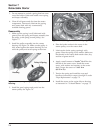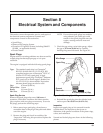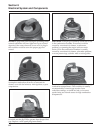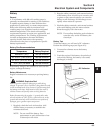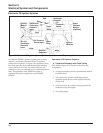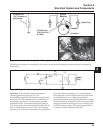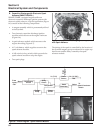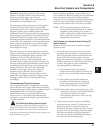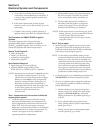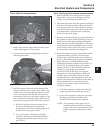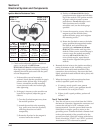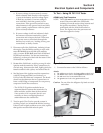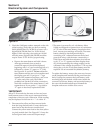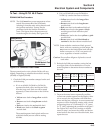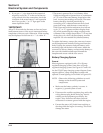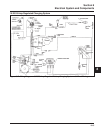
8.8
Section 8
Electrical System and Components
a. If one side is not firing, check all wiring,
connections, and terminations on that side. If
wiring is okay, replace ignition module and
retest for spark.
b. If the tester shows spark, but the engine
misses or won’t run on that cylinder, try a new
spark plug.
c. If neither side is firing, recheck position of
ignition switch and check for shorted kill lead.
Test Procedure for SMART-SPARK
TM
Ignition
Systems
The following procedures are provided for
troubleshooting ignition problems on SMART-
SPARK
TM
equipped engines. They will allow you to
isolate and pinpoint the failed component(s).
Special Tools Required:
• Hand Tachometer
• Tester* (see Section 2)
• Automotive timing light
• Multi-meter (digital)
Specifications Required:
• Spark plug gap 0.76 mm (0.030 in.)
• Ignition module air gap 0.28/0.33 mm
(0.011-0.013 in.), 0.30 mm (0.012 in.) nominal
*NOTE: Ignition tester (see Section 2) must be used to
test ignition on these engines. Use of any
other tester can result in inaccurate findings.
Battery on unit must be fully charged and
properly connected before making any of
these tests (a battery that is hooked up or
charged backward will crank the engine, but
it won’t have spark). Be sure drive is in
neutral and all external loads are
disconnected.
Test 1. Isolate and verify the trouble is within the
engine ignition system.
1. Locate the plug connectors where the wiring
harnesses from the engine and equipment are
joined. Separate the connectors and remove the
white “kill” lead from the engine connector.
Rejoin the connectors and position or insulate the
kill lead terminal so it cannot touch ground. Try
to start** the engine to verify whether the
reported problem is still present.
a. If the problem is gone, the electrical system on
the unit is suspect. Check the key switch,
wires, connections, safety interlocks, etc.
b. If the problem persists the condition is
associated with the ignition or electrical
system of the engine. Leave the kill lead
isolated until all testing is completed.
**NOTE: If the engine starts or runs during any of the
testing, you may need to ground the kill lead
to shut it down. Because you have
interrupted the kill circuit, it may not stop
using the switch.
Test 2. Test for spark.
1. With the engine stopped, disconnect one spark
plug lead. Connect the spark plug lead to post
terminal of spark tester (see Section 2) and attach
tester clip to a good engine ground.
NOTE: If two testers are available, testing can be
performed simultaneously for both cylinders.
However, if only one tester is available, two
individual tests must be performed. The side
not being tested must have the spark plug
lead connected or grounded. Do not crank
the engine or perform tests with one spark
plug lead disconnected and not grounded or
permanent system damage may occur.
2. Crank the engine over, establishing a minimum of
550-600 RPM, and observe tester(s) for spark.
3. On a twin cylinder engine, repeat the spark test
on the opposite cylinder if cylinders are being
tested individually.
a. If both cylinders have good spark, but the
engine runs poorly, install new spark plugs
gapped at 0.76 mm (0.030 in.), and retest
engine performance. If problem persists, go
to Test 3.
b. If one cylinder had good spark, but the
other cylinder had no spark or intermittent
spark, go to Test 3.
c. If there was no spark or intermittent spark
on both cylinders, go to Test 4.



